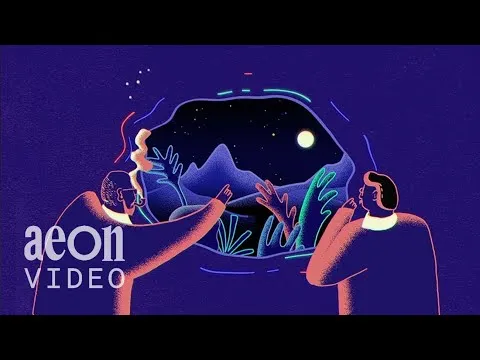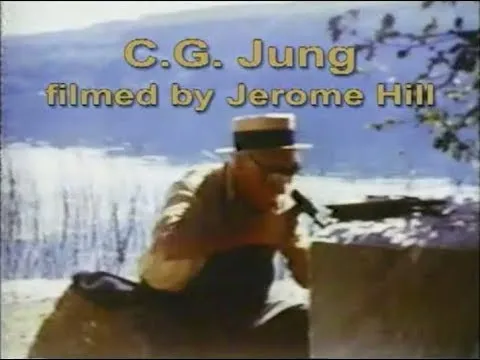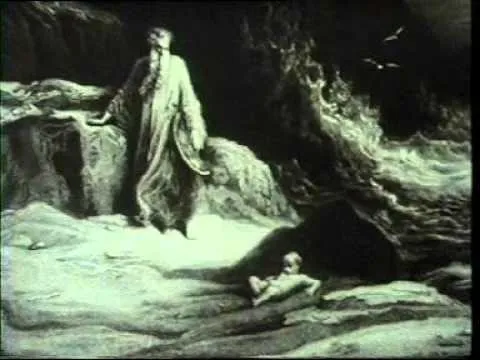The Dialectics of Liberation: Anarchism, Existentialism, and Decentralism.
Humanism and Existentialism: Part 6 - Carl Gustav Jung, I - Myths and Archetypes
"We are denying the main object of existence, our preservation" - charlie777pt
1 - Introduction
"There is no birth of consciousness without pain." - Carl Jung
This post about Carl Jung will be a divide in two parts because the multitude of concepts involved in his theories can't be digestible in only one post, that would incur in the risk of de-characterization of his theory.
Carl Jung refers that he had a stressy childhood, with a mother prone to isolation caused by the "spirits", that at night would come to haunt her, and she had to escape and isolate in her room, a habit that created in him a profound fear of his mother.
After reading Kraft Ebding, he found out a phrase saying that psychosis was a disease of the personality, that changed his way of dealing with human spirit making Jung decide to be an alienist, after his decision to be a doctor in medicine.
Jung met Freud who assumes a fatherly position to give his new son the inheritance of the Feudo of Psychoanalysis, which can be well perceived in the first video below.
As many others members that joined of The Vienna Club, like Otto Rank and Wilhelm Reich, when they created personal ideas that could damage the holy dogma of psychoanalysis, they had to be punished, expelled and excommunicated, the same happened to Carl Jung.
His subjective dialectics of the duality of opposing forces of human nature like yin/yang and inside/outside was another different view of Freud's objective trinities like oral/anal/genital and id/ego/superego.
"We cannot change anything until we accept it. Condemnation does not liberate, it oppresses." Carl Jung
2 - Carl Jung (1875-1961) - Myths and Archetypes
"There is no birth of consciousness without pain." - Carl Jung
Carl Jung studied manifestations of the Collective Unconscious, where lives the Universal Archetypes revealed in works of Art, or in the Dream Therapy centered in the Self, that he couldn't see as an object but rather as an experience, that could be accessed for example in the form of the Mandala's symbolism.
He materialized this phenomenon in all the mandalas that he draw after 1916, like diagrams revealing the structures of the mind, dating from the Himalayan Buddhism that used it for meditation, and also some less rich one's still seen in some icons of the Christian church, All these mandalas can all be seen in the recently published "The Red Book", that was always at Jung's desk and contains all his designs.
He introduced the art of the mandalas to the western civilization, that are like a kind of fractal that emanate the mind forces converging to a center, like a kind of black hole dissolving the opposing energies of inner hidden contradictions of the thought, as well the spirals, of the symbolic humanity's myths as archetypal content.
"we discover mandala symbols in the products of the unconscious" - Carl Jung
He saw that dreams, works of art, and human manifestations, represents the primordial symbolic and mythical world, that he attempts to find the meaning in the archetypes.
The collective unconscious is the repository of the share of human memory that he called Archetypes, like structural inherited patterns from the myths of culture(s).
If we don't get aware of these inner contradictions, it will appear outside of our life as Fate,e taking over the construction of our own Destiny that is in our hands.
“Today humanity, as never before, is split into two apparently irreconcilable halves"…"The psychological rule says that when an inner situation is not made conscious, it happens outside, as fate. That is to say, when the individual remains undivided and does not become conscious of his inner contradictions, the world must perforce act out the conflict and be torn into opposite halves." - Carl Jung
Carl Jung lived almost all his life in a house in nature without electricity or water and he made everything from fire to cook, wash his clothes, and even grow his own potatoes and vegetables because he was identified with the idea of being a simple man, living in total communion with nature and the ecosystem.
Carl Jung was undoubtedly one of the pillars in the foundation of humanistic and transpersonal psychology, centered in the individual.
He knew that science had no place in dealing with the Conscious and the Unconscious world because rationality could explain the external physical world but not the irrational mythical realm of the Mind, that man and woman used to express his individual myths and affirm the singularity of our life.
Jung besides drawing Mandalas, also liked to express his inner dark side of the mind in sculptures he made all his life, trying to create outside manifestations of the unknown spiritual territory of the archetypes inhabiting his soul, and as he said dreams, art and imagination are the oracles to find answers, to choose our future path of life, and to find a full spiritual plenitude and a truer life, as an individuation process.
"Who looks outside, dreams; who looks inside, awakes." Carl Jung
The process of individuation is very similar to the principle of self-actualization, putting the self in the center of people's capacity to change and to find fulfillment in their life, finding this force in search of his unconscious.
He dived into agnosticism, studied alchemy and archeology, and even made the first western world translation of the book I Ching that I own the first edition in the English language, that was one of my books near the bed for years, along with the book "Knots" of Ronald D. Laing.
He embraced and studied all religions and got a multiple mixed faith, that was not normal in his times on a western man, providing him with an infinite tolerance and respect for any manifestation of man and culture, that can open the dialogue in our total polarized world of beliefs, cultural and religious intolerance, translated in this warmongering era, that shuts up mutual understanding and human compassion.
"My life is the story of the self-realization of the Unconscious." - Carl Jung
He had a private meditation room still closed today to the public, where he visited his inner world, to come outside later to the real world of his garden and get in direct contact with the nature as the realm of the outside world.
He saw religion as a projection of our inner being that people use, as a psychological manifestation of men and women, like a connection of the inside with the cosmic level of a divine holistic entity.
But as he stressed, it had nothing to do with the christian thought of god, that he abandoned in his childhood, and with aging, he arrived at the concept of "no god" of the religious naturalism, that when you know yourself, then you know god in the perfect connection with nature.
3 - Carl Jung - The Theory, Archetypes, and Functions
“The meeting of two personalities is like the contact of two chemical substances: if there is any reaction, both are transformed.” - Carl Jung
The human psyche is moved by hidden archetypal forces, and every human being has an archetype, for example, the "concept" of Mother that is shared by all people in any culture.
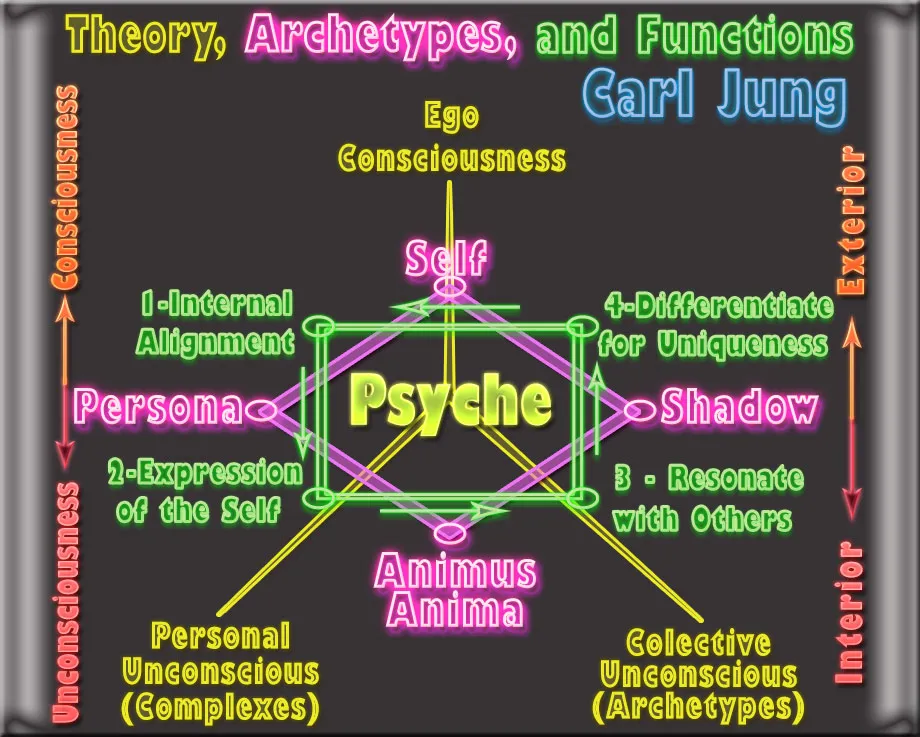
The Archetypes are entangled with our Instincts in the form of the Collective Unconscious mind, that influence us in conjunction with our Personal Unconsciousness (complexes).
“The archetype is a force. It has autonomy. It can suddenly seize you. It is like a seizure.” - Carl Jung
The four major Jung's archetypes are the Persona, the Shadow, the Anima/Animus, and the unifying Self.
- The Persona (composed of person and personality) represents our public image, the way we act socially like a 'mask' we ware to manifest our Self in existence.
“(The persona) is a kind of mask, designed on the one hand to make a definite impression upon others, and on the other to conceal the true nature of the individual.” ... “the persona is a semblance... the dissolution of the persona is therefore absolutely necessary for individuation." - Carl Jung
- The Shadow is our darkest and veiled part of the mind, where our shame and guilt is hidden inside, that we must drill inside to find our self.
"The Shadow is a moral problem that challenges the whole ego-personality, for no one can become conscious of the shadow without considerable moral effort. To become conscious of it involves recognizing the dark aspects of the personality as present and real. This act is an essential condition for any kind of self-knowledge."
- The Anima/Animus is one duality, where the Anima is the female aspect inhabiting in the collective unconscious of men, and the Animus is the male aspect living in the collective unconscious of women, a concept with a lot of relation to the Yin/Yang theory.
"The acceptance of femininity leads to completion. The same is valid for the woman who accepts her masculinity." - Carl Jung
- The Self is the archetypal organization, like a totalization of the other three constituting parts that drives the person in the process of finding uniqueness and individuation.
"Man can't stand a meaningless life."- Carl Jung
Mandalas are all based in the square of a circle, expressing the duality of forces in the human psyche.
A Buddhist Mandala: Image Source
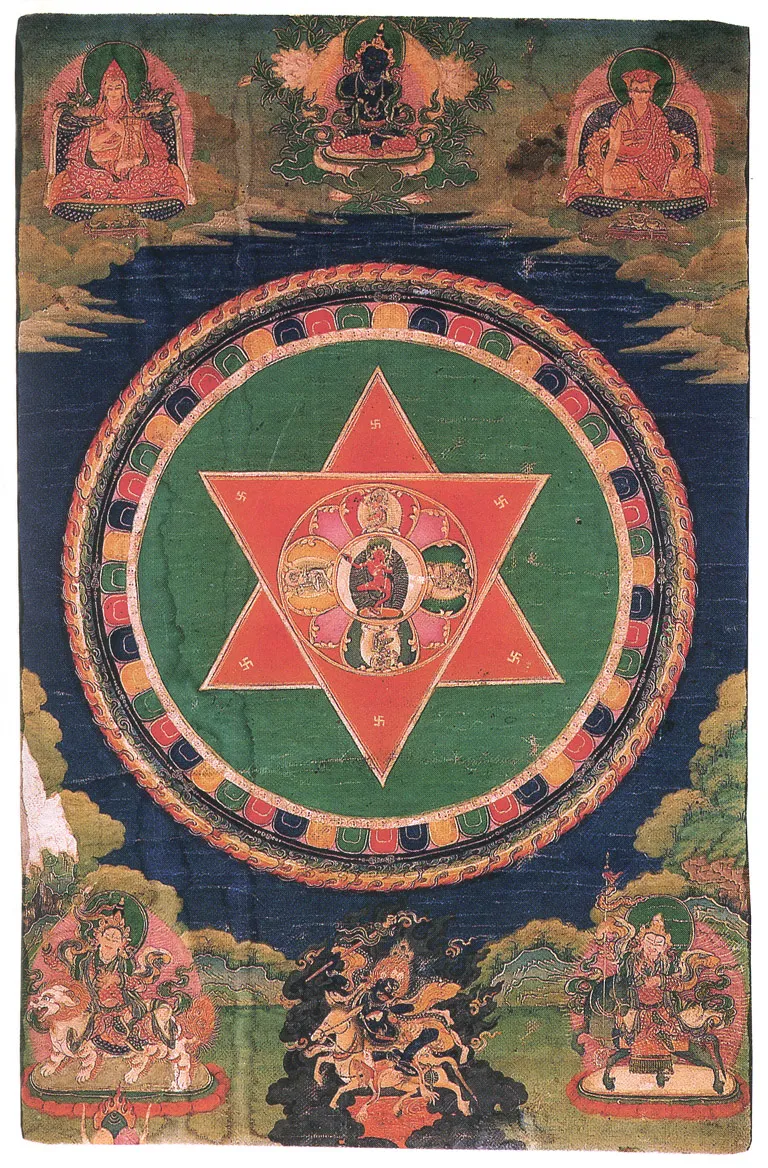
It is strange to find in this mandala of Buddhism, which may have inspired the swastika which would be the example of using a symbol of good to use in evil, one of the many human dualities that Jung tried to unravel.
"You are what you do, not what you say you'll do" - Carl Jung
In the next post, I'll continue to talk about Carl Jung, mainly about the personality types and how anyone that wants to meet her/his Self, can do the Meyers-Briggs Personality Type Test and use the results all your life
Further reading:
See Carl Jung Mandalas from The Red Book
Videos:
Philosophy Feuds: Freud vs Jung
C.G. Jung at Bollingen – Rare Documentary Footage
Carl Gustav Jung - Inheritance of Dreams
Carl Jung: "The world hangs on a thin thread...."
The Dialectics of Liberation: Anarchism, Existentialism, and Decentralism.
Published Posts:
- Introduction to the Dialectics of Liberation: Anarchism, Existentialism and Decentralism
I - Anarchism
- What is Anarchism?
- The History of Anarchism
- Part 1 - Pre-Anarchy - Social Revolution
- Anarchy: Revolution Against The State
- Part 2 - Anarcho-Federalism
- Part 3 - Libertarian Anarchism
- Part 4 - Anarcho-Syndicalism
- Anarchy Today
- Index and Conclusions of part 1 - Anarchy
- Part 1 - Pre-Anarchy - Social Revolution
- Anarchy: Revolution Against The State
- Part 2 - Anarcho-Federalism
- Part 3 - Libertarian Anarchism
- Part 4 - Anarcho-Syndicalism
II - Existentialism
- What is Existentialism ?
- Part 1 - Unplugged Introduction to Existentialism
- Part 2 - The Short History of Existentialism: I - Early Pre-existentialism
- Part 2 - The Short History of Existentialism: II - Pre-Existentialists
- Part 2 - The Short History of Existentialism: III - Phenomenology - Brentano to Husserl
- Part 2 - The Short History of Existentialism: III - Phenomenology - Jaspers to Sheller
- Part 2 - The Short History of Existentialism: IV - Humanistic Existentialists - Buber, Arendt, and Tillich
- Part 2 - The Short History of Existentialism: V - Humanistic Existentialists - Rollo May
- Part 2 - The Short History of Existentialism: V - Humanistic Existentialists - Abraham Maslow
- Part 2 - The Short History of Existentialism: VI - Post -Structuralism - Jacques Lacan
- Part 2 - The Short History of Existentialism: VI - Post -Structuralism - Michel Foucault
- Part 2 - The Short History of Existentialism: VI - Post -Structuralism - Emmanuel Levinas
- Part 2 - The Short History of Existentialism: VI - Post -Structuralism - Jacques Derrida
- Part 2 - The Short History of Existentialism: VI - Post -Structuralism - Paul Ricouer
- Part 3 - The Philosophy of Existentialism: I - Existentialism Today
- Part 3 - The Philosophy of Existentialism: II - Fascism and Existentialism
- Part 3 - The Philosophy of Existentialism: III - The Fear of Tthinking
- Part 3 - The Philosophy of Existentialism: IV - Is Direct Democracy back with The Yellow Vests?
- Part 3 - The Philosophy of Existentialism:V - Existentialism:What is real in the Reality?
- Part 3 - The Philosophy of Existentialism:VI - Existentialism: The Ghost in the Machine
- Part 3 - The Philosophy of Existentialism: VII - The Meaning of Nonsense
- Part 3 - The Philosophy of Existentialism: VIII - The Players and the Times - Now and Then
- The "Existentialists"
- Part 1 - Gabriel Marcel - The Neo-Socratic
- Part 2 - Jean-Paul Sartre - The Man of The 20th Century
- Part 3 - Simone de Beauvoir - The Castor
- Part 4 - Albert Camus - The Absurdist
- Part 5 - Merleau-Ponty - The Humanist Existentialist
- Part 6 - Existentialism in the Streets: The Extinction Rebellion(XR) Weather Report
- Humanism and Existentialism
- Part 1 - Humanistic Psychology and Existential Psychotherapies
- Part 2 - Humanistic Psychologists - Otto Rank
- Part 3 - Humanistic Psychologists - Carl Rogers
- Part 4 - Erich Fromm - The Fear of Freedom
- Part 5 - Wilhelm Reich - The Orgasm and the Character Shield
- Part 6 - Carl Gustav Jung: I- Myths and Archetypes - This post
- Part 1 - Unplugged Introduction to Existentialism
- Part 2 - The Short History of Existentialism: I - Early Pre-existentialism
- Part 2 - The Short History of Existentialism: II - Pre-Existentialists
- Part 2 - The Short History of Existentialism: III - Phenomenology - Brentano to Husserl
- Part 2 - The Short History of Existentialism: III - Phenomenology - Jaspers to Sheller
- Part 2 - The Short History of Existentialism: IV - Humanistic Existentialists - Buber, Arendt, and Tillich
- Part 2 - The Short History of Existentialism: V - Humanistic Existentialists - Rollo May
- Part 2 - The Short History of Existentialism: V - Humanistic Existentialists - Abraham Maslow
- Part 2 - The Short History of Existentialism: VI - Post -Structuralism - Jacques Lacan
- Part 2 - The Short History of Existentialism: VI - Post -Structuralism - Michel Foucault
- Part 2 - The Short History of Existentialism: VI - Post -Structuralism - Emmanuel Levinas
- Part 2 - The Short History of Existentialism: VI - Post -Structuralism - Jacques Derrida
- Part 2 - The Short History of Existentialism: VI - Post -Structuralism - Paul Ricouer
- Part 3 - The Philosophy of Existentialism: I - Existentialism Today
- Part 3 - The Philosophy of Existentialism: II - Fascism and Existentialism
- Part 3 - The Philosophy of Existentialism: III - The Fear of Tthinking
- Part 3 - The Philosophy of Existentialism: IV - Is Direct Democracy back with The Yellow Vests?
- Part 3 - The Philosophy of Existentialism:V - Existentialism:What is real in the Reality?
- Part 3 - The Philosophy of Existentialism:VI - Existentialism: The Ghost in the Machine
- Part 3 - The Philosophy of Existentialism: VII - The Meaning of Nonsense
- Part 3 - The Philosophy of Existentialism: VIII - The Players and the Times - Now and Then
- Part 1 - Gabriel Marcel - The Neo-Socratic
- Part 2 - Jean-Paul Sartre - The Man of The 20th Century
- Part 3 - Simone de Beauvoir - The Castor
- Part 4 - Albert Camus - The Absurdist
- Part 5 - Merleau-Ponty - The Humanist Existentialist
- Part 6 - Existentialism in the Streets: The Extinction Rebellion(XR) Weather Report
- Part 1 - Humanistic Psychology and Existential Psychotherapies
- Part 2 - Humanistic Psychologists - Otto Rank
- Part 3 - Humanistic Psychologists - Carl Rogers
- Part 4 - Erich Fromm - The Fear of Freedom
- Part 5 - Wilhelm Reich - The Orgasm and the Character Shield
- Part 6 - Carl Gustav Jung: I- Myths and Archetypes - This post
Next posts on the Series:
II - Existentialism(Cont.)
- Humanism and Existentialism
- Part 6 - Carl Gustav Jung: II- Psychological Types
- Part 7 - Thomas Szasz - The Factory of Madness
- Existentialism and Anarchism
- The Future : Posthumanism, transhumanism and inhumanism
- Part 6 - Carl Gustav Jung: II- Psychological Types
- Part 7 - Thomas Szasz - The Factory of Madness

